2) Stanford 7-0-1 (9-1-1)
3) Alabama 7-0 (10-0)
4) Pittsburgh 6-1 (8-1)
5) Princeton 6-0 (7-1)
6) Illinois 6-0 (7-1)
7) Navy 7-0 (8-1)
8) Colgate 4-1 (7-1)
9) Ohio State 5-1 (7-1)
10) Syracuse 6-0 (6-2)
11) Santa Clara 5-0-1 (7-2-1)
12) Rice 7-0-1 (9-1-1)
13) Louisiana State 5-0-2 (7-2-2)
14) Army 6-1 (7-3)
15) Temple 6-0-1 (7-1-2)
16) Southern Methodist 5-1-2 (8-2-2)
17) Purdue 4-2 (5-3)
18) St. Mary's (California) 4-2 (7-2)
19) Washington State 4-2 (4-3-1)
20) Washington 4-1 (6-1-1)
21) Columbia 5-1 (7-1)
Trinity (Connecticut) 7-0 (7-0)
I am not going to be fixing this poll the way I fixed all the final AP weekly polls that started in 1936, since it was conducted in mid-season and was not intended to be the final say on the season as a whole. Still, this poll is a good place to start, because it gives us an idea which teams sportswriters would have voted for at the end of the season.
Two of these teams were "upset" in bowl games, #2 Stanford losing to #3 Alabama in the Rose and #15 Temple losing to unranked Tulane in the Sugar. But there were far more "upsets" in the last weeks of the regular season, when these teams took a total of 12 losses and 2 ties to lower-rated opponents, 11 of those opponents not rated at all. So these mid-November rankings were, as one would expect, not particularly close to correct by season's end.
Our post-bowl top 3 are #1 Minnesota, #2 Alabama, and #3 Pittsburgh. Detailed information on why, along with full summaries of Minnesota and Alabama, can be found in my article on the 1934 national championship. On to #4...
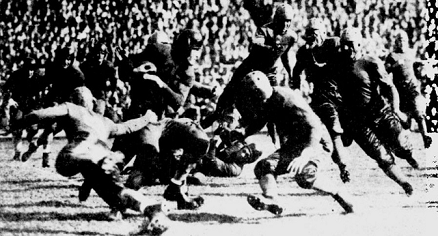
Minnesota's consensus All American halfback Pug Lund carrying the ball in 1934's game of the year, Minnesota at Pittsburgh. This was one of the best games of the 1930s. Minnesota scored 2 touchdowns in the 4th quarter to rally for a 13-7 win. No other team came close to either Minnesota or Pittsburgh this season.

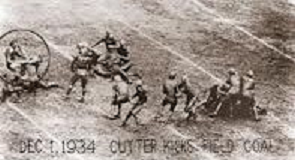
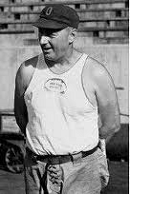 Ohio
State will have to settle for #5. They featured a pair of nonconsensus
All Americans, end Merle Wendt and guard and captain Regis Monahan,
whose face graced Wheaties boxes the following Spring. Monahan played
for the 1935 NFL champion Detroit Lions the next year. The coach was
Hall of Famer Francis Schmidt (pictured), a Nebraska graduate who had
previously gone 24-3-2 at Tulsa 1919-1921, 41-21-3 at Arkansas
1922-1928, and 45-6-5 at Texas Christian 1929-1933. Four of those teams
were unbeaten with 1 tie.
Ohio
State will have to settle for #5. They featured a pair of nonconsensus
All Americans, end Merle Wendt and guard and captain Regis Monahan,
whose face graced Wheaties boxes the following Spring. Monahan played
for the 1935 NFL champion Detroit Lions the next year. The coach was
Hall of Famer Francis Schmidt (pictured), a Nebraska graduate who had
previously gone 24-3-2 at Tulsa 1919-1921, 41-21-3 at Arkansas
1922-1928, and 45-6-5 at Texas Christian 1929-1933. Four of those teams
were unbeaten with 1 tie.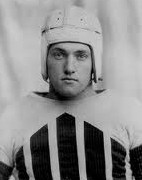
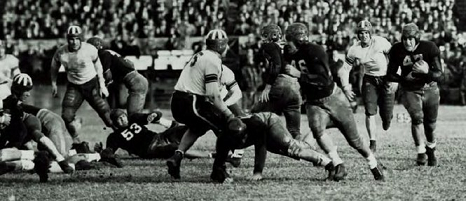
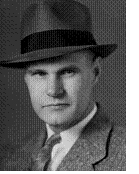 9-1-1
Rice, again, took an upset loss and a tie, while 7-1-1 North Carolina
took just 1 upset tie, so UNC had the better relevant record, and we'll
therefore bring them in next at #14.
9-1-1
Rice, again, took an upset loss and a tie, while 7-1-1 North Carolina
took just 1 upset tie, so UNC had the better relevant record, and we'll
therefore bring them in next at #14.